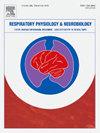Diaphragm pacing elicits respiratory plasticity in awake rodents after C2 hemisection
IF 1.6
4区 医学
Q3 PHYSIOLOGY
引用次数: 0
Abstract
Cervical spinal cord injury (cSCI) creates profound respiratory deficits that are commonly managed with chronic mechanical ventilation. Diaphragm pacing (DP) is an emerging clinical intervention designed to combat the deleterious effects associated with chronic mechanical ventilation. While anecdotal evidence suggests that DP may restore independent breathing, the impact of daily DP on respiratory output is unknown. Therefore, we investigated if DP induces ventilatory and diaphragm electromyography (EMG) plasticity in awake rodents following cSCI. All animals (n = 42) were implanted with diaphragm EMGs, received a left incomplete C2 hemisection, and were treated with DP, DP + dorsal rhizotomy, or served as controls (no DP). In animals receiving a dorsal rhizotomy, the left cervical dorsal roots (C4-C6) were cut to test if phrenic afferents are necessary for the induction of plasticity. One week after C2 hemisection, we delivered daily DP for 1 h/day (5 min on/5 min off) and recorded ventilation and diaphragm EMG output for 60 min over 4 consecutive days. During DP, we found an increase in tidal volume. After DP, tidal volume remained elevated in males for at least 60 min, and to a lesser extent in females. DP increased diaphragm EMG amplitude 60 min post-pacing in males, but not females. Despite an identical DP intervention, rhizotomy treated male animals did not exhibit a sustained increase in tidal volume or EMG amplitude. Our data suggests that DP induces phrenic afferent dependent plasticity characterized by a long-lasting increase in tidal volume and diaphragm EMG amplitude in awake male rodents following cSCI.
横膈膜起搏引起清醒啮齿动物C2半切后的呼吸可塑性
颈脊髓损伤(cSCI)造成严重的呼吸缺陷,通常通过慢性机械通气进行治疗。隔膜起搏(DP)是一种新兴的临床干预措施,旨在对抗与慢性机械通气相关的有害影响。虽然坊间证据表明,DP可以恢复独立呼吸,但每日DP对呼吸输出量的影响尚不清楚。因此,我们研究了DP是否会诱导cSCI后清醒啮齿动物的通气和膈肌电图(EMG)可塑性。所有动物(n = 42)植入膈肌肌电图,接受左C2半切断术,DP、DP + 背根切断术治疗,或作为对照组(未DP)。在接受背根切开术的动物中,左颈背根(C4-C6)被切断,以测试颅传入神经是否对可塑性的诱导是必要的。C2半切一周后,我们每天进行1 h/天的DP(5 min开/5 min关),并连续4天记录通气和膈肌肌电输出60 min。DP期间,我们发现潮汐量增加。DP后,男性潮气量升高至少60 min,女性潮气量升高程度较小。DP增加男性起搏后膈肌肌电振幅60 min,而女性没有。尽管进行了相同的DP干预,根切断术治疗的雄性动物并没有表现出潮汐量或肌电图振幅的持续增加。我们的数据表明,DP诱导膈传入依赖的可塑性,其特征是cSCI后醒着的雄性啮齿动物的潮汐量和膈肌肌电图振幅的持续增加。
本文章由计算机程序翻译,如有差异,请以英文原文为准。
求助全文
约1分钟内获得全文
求助全文
来源期刊
CiteScore
4.80
自引率
8.70%
发文量
104
审稿时长
54 days
期刊介绍:
Respiratory Physiology & Neurobiology (RESPNB) publishes original articles and invited reviews concerning physiology and pathophysiology of respiration in its broadest sense.
Although a special focus is on topics in neurobiology, high quality papers in respiratory molecular and cellular biology are also welcome, as are high-quality papers in traditional areas, such as:
-Mechanics of breathing-
Gas exchange and acid-base balance-
Respiration at rest and exercise-
Respiration in unusual conditions, like high or low pressure or changes of temperature, low ambient oxygen-
Embryonic and adult respiration-
Comparative respiratory physiology.
Papers on clinical aspects, original methods, as well as theoretical papers are also considered as long as they foster the understanding of respiratory physiology and pathophysiology.

 求助内容:
求助内容: 应助结果提醒方式:
应助结果提醒方式:


